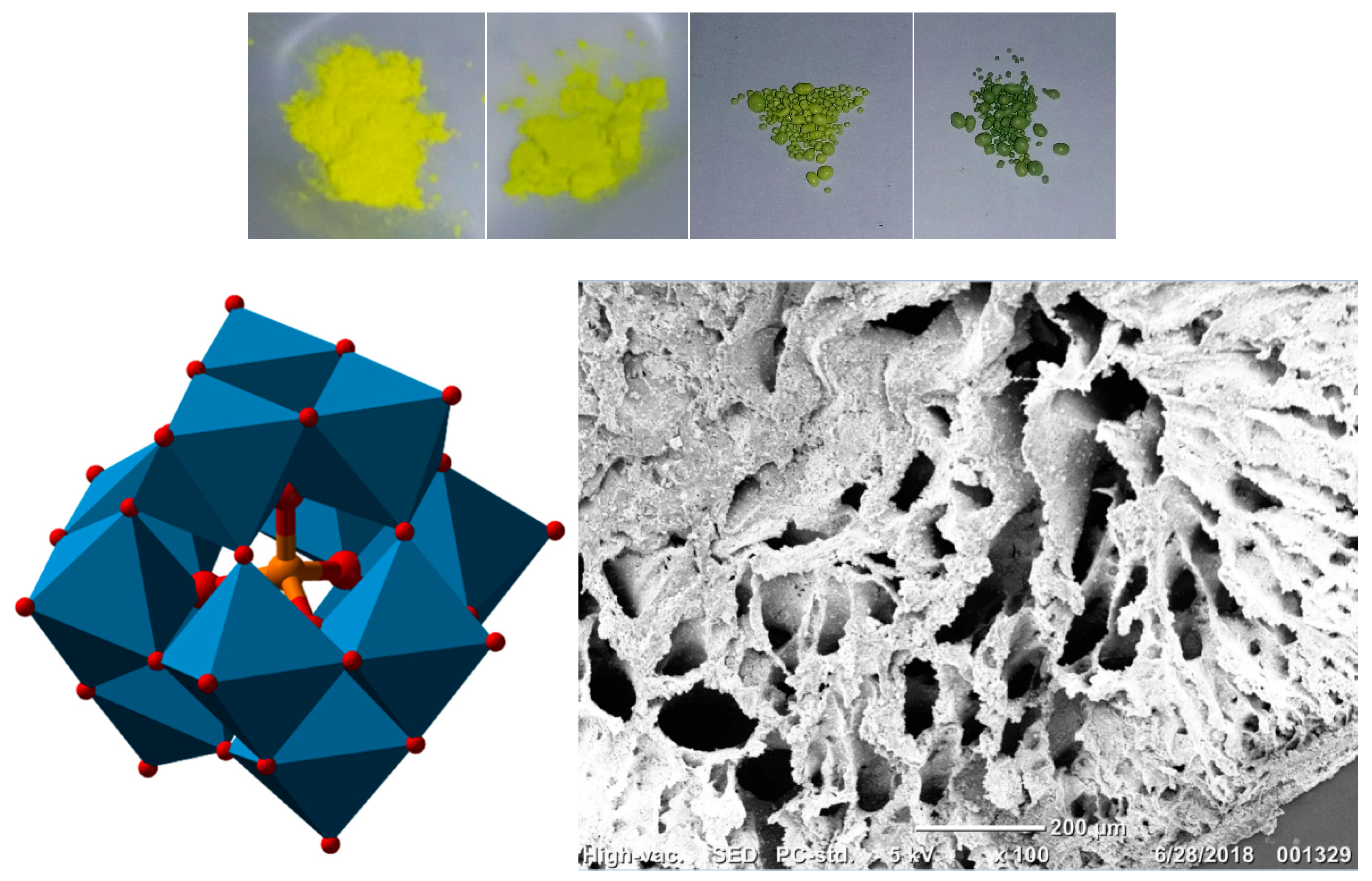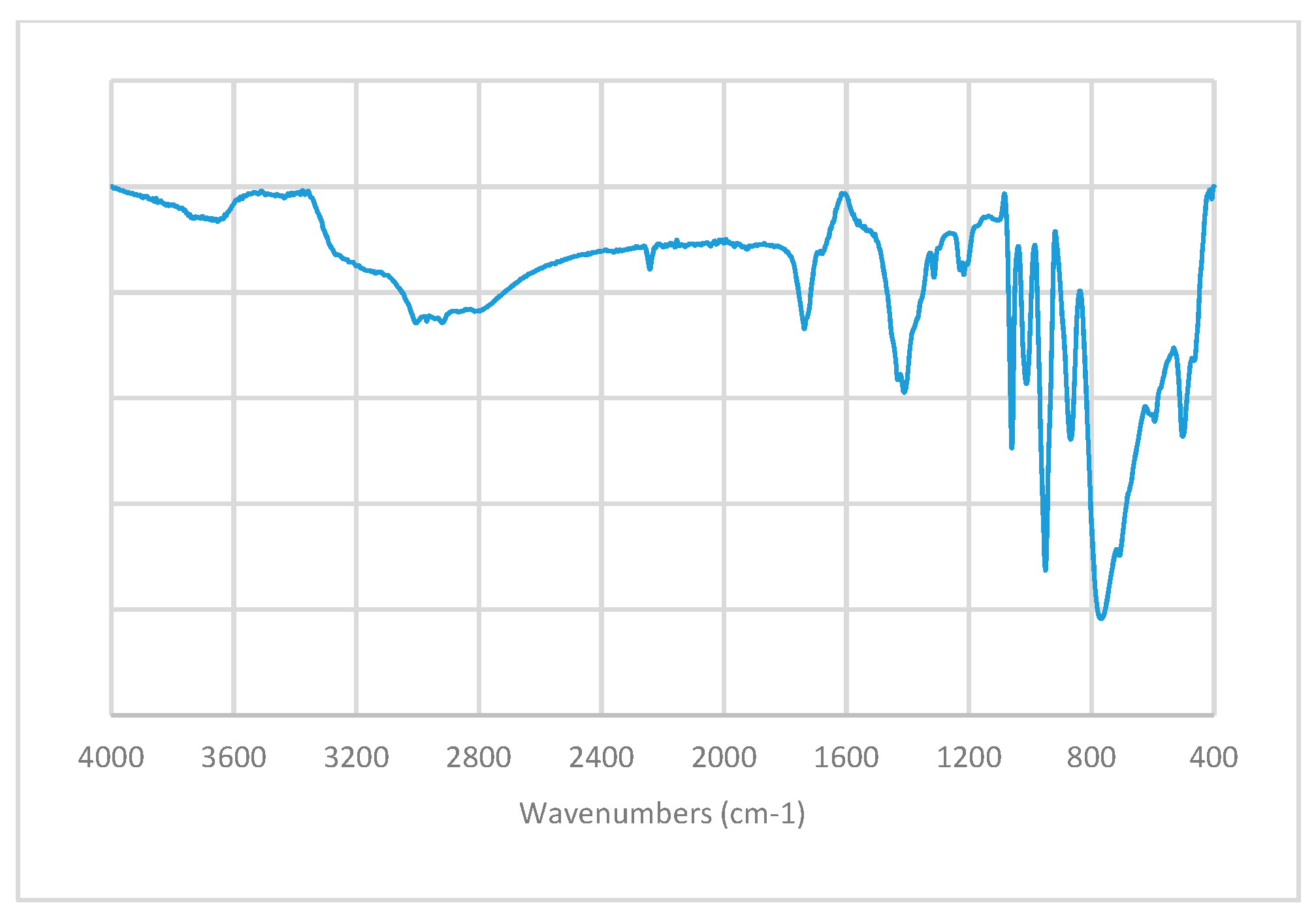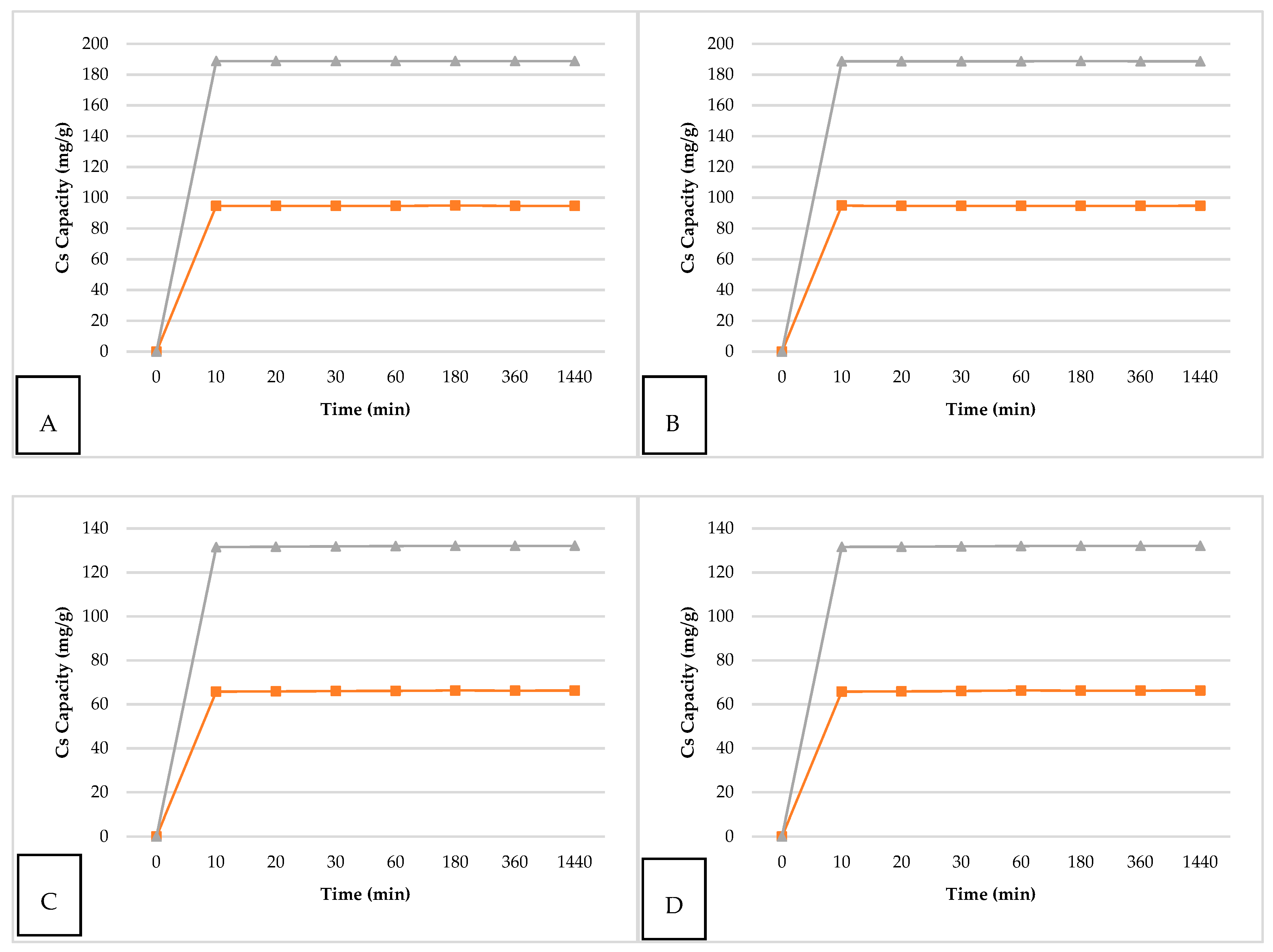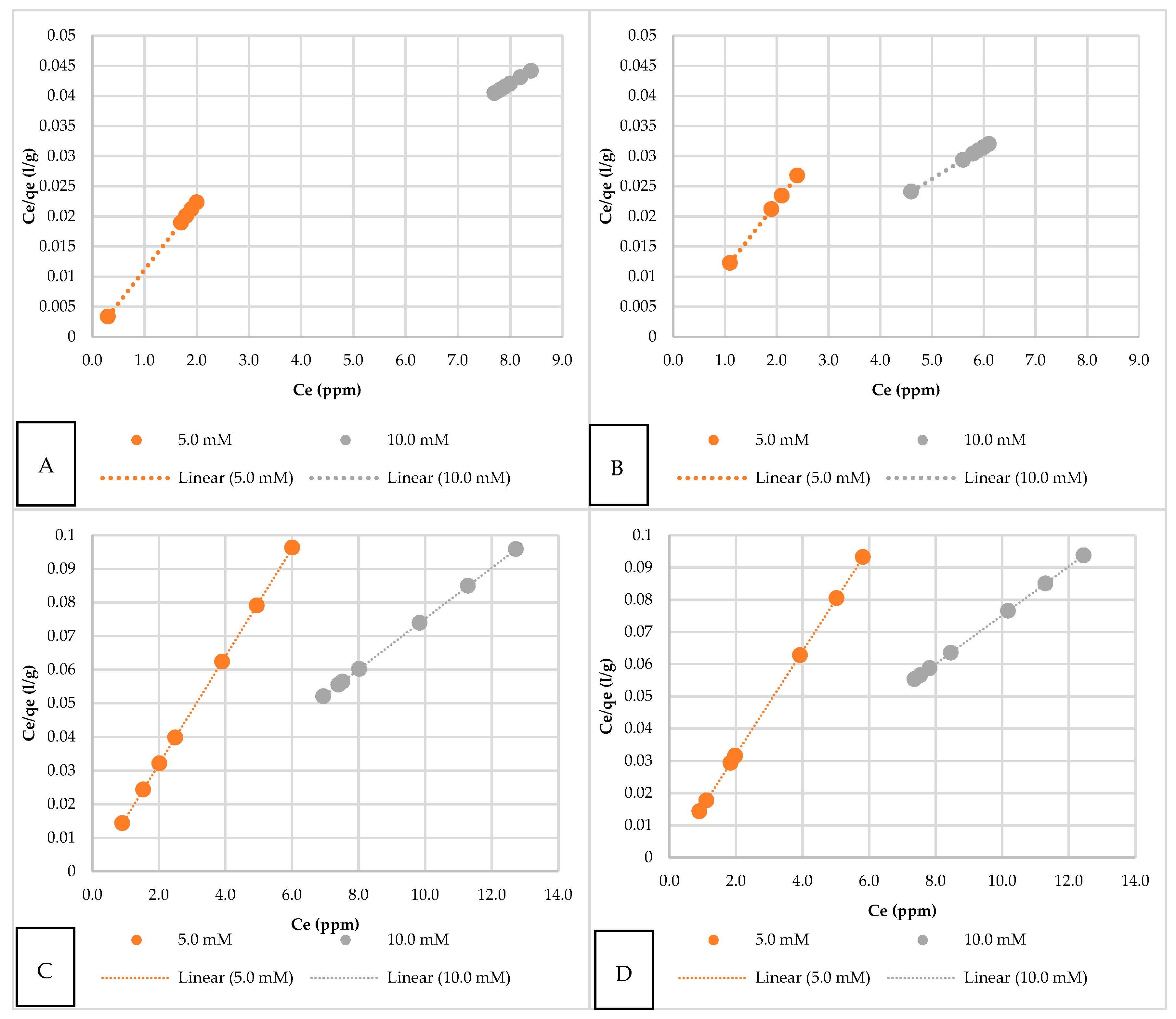The Effect of Gamma Irradiation on the Ion Exchange Properties of Caesium-Selective Ammonium Phosphomolybdate-Polyacrylonitrile (AMP-PAN) Composites under Spent Fuel Recycling Conditions
Abstract
:1. Introduction
2. Materials and Methods
2.1. Materials, AMP-PAN Composite Preparation and Characterisation
2.2. Irradiation
2.3. Ion Exchange Performance
3. Results and Discussion
3.1. Overview
3.2. Ion Exchange Performance
4. Conclusions
Author Contributions
Funding
Acknowledgments
Conflicts of Interest
References
- Tavoni, M.; van der Zwaan, B. Nuclear Versus Coal plus CCS: A Comparison of Two Competitive Base-Load Climate Control Options. Environ. Model. Assess. 2011, 16, 431–440. [Google Scholar] [CrossRef]
- Nuclear Wastes: Technologies for Separations and Transmutation; National Academy Press: Washington, DC, USA, 1996.
- Aoyama, M. Evidence of stratospheric fallout of caesium isotopes from the Chernobyl accident. Geophys. Res. Lett. 1988, 15, 327–330. [Google Scholar] [CrossRef]
- Livens, F.R.; Loveland, P.J. The influence of soil properties on the environmental mobility of caesium in Cumbria. Soil Use Manag. 1988, 4, 69–75. [Google Scholar] [CrossRef]
- Maguire, S.; Pulford, I.D.; Cook, G.T.; Mackenzie, A.B. Caesium sorption—desorption in clay—humic acid systems. J. Soil Sci. 1992, 43, 689–696. [Google Scholar] [CrossRef]
- Desmet, G.M.; van Loon, L.R.; Howard, B.J. Chemical speciation and bioavailability of elements in the environment and their relevance to radioecology. Sci. Tot. Environ. 1991, 100, 105–124. [Google Scholar] [CrossRef]
- Dyer, A.; Pillinger, M.; Amin, S. Ion exchange of caesium and strontium on a titanosilicate analogue of the mineral pharmacosiderite. J. Mater. Chem. 1999, 9, 2481–2487. [Google Scholar] [CrossRef]
- Vlasselaer, S.; D’Oliefslager, W.; D’Hont, M. Caesium ion exchange equilibrium on potassium-zinc-hexacyanoferrate(II) K2Zn3(Fe(CN)6)2. J. Radioanal. Chem. 1977, 35, 211–222. [Google Scholar] [CrossRef]
- Amphlett, C.B.; McDonald, L.A. Equilibrium studies on natural ion-exchange minerals—I. Caesium and strontium. J. Inorg. Nulc. Chem. 1956, 2, 403–414. [Google Scholar] [CrossRef]
- Alberti, G.; Costantino, U.; Allulli, S.; Massucci, M.A. Preparation and ion-exchange properties of a new phase of the crystalline titanium phosphate, Ti(HPO4)2·2H2O. J. Inorg. Nucl. Chem. 1975, 37, 1779–1786. [Google Scholar] [CrossRef]
- Valsala, T.P.; Roy, S.C.; Shah, J.G.; Gabriel, J.; Raj, K.; Venugopal, V. Removal of radioactive caesium from low level radioactive waste (LLW) streams using cobalt ferrocyanide impregnated organic anion exchanger. J. Haz. Mater. 2009, 166, 1148–1153. [Google Scholar] [CrossRef] [PubMed]
- Saberi, R.; Nilchi, A.; Garmarodi, S.R.; Zarghami, R. Adsorption characteristic of 137Cs from aqueous solution using PAN-based sodium titanosilicate composite. J. Radioanal. Nucl. Chem. 2010, 284, 461–469. [Google Scholar] [CrossRef]
- Nilchi, A.; Saberi, R.; Rasouli Garmarodi, S.; Bagheri, A. Evaluation of PAN-based manganese dioxide composite for the sorptive removal of cesium-137 from aqueous solutions. Appl. Rad. Isotop. 2012, 70, 369–374. [Google Scholar] [CrossRef]
- Gelis, V.M.; Kharitonov, O.V.; Firsova, L.A.; Milyutin, V.V.; Semenova, T.A.; Lugomov, M.V. Sorption extraction of caesium-137 on ammonium phosphomolybdate from technological products in the preparation of high-level samples for elemental analysis. Issues Rad. Saftey 2009, 1, 3–11. [Google Scholar]
- van, R.; Smit, J.; Jacobs, J.J.; Robb, W. Cation exchange properties of the ammonium heteropolyacid salts. J. Inorg. Nucl. Chem. 1959, 12, 95–103. [Google Scholar] [CrossRef]
- van, R.; Smit, J.; Robb, W.; Jacobs, J.J. Cation exchange on ammonium molybdophosphate—I: The alkali metals. J. Inorg. Nucl. Chem. 1959, 12, 104–112. [Google Scholar] [CrossRef]
- Sebesta, F.; Stefula, V. Composite ion exchanger with ammonium molybdophosphate and its properties. J. Radioanal. Nucl. Chem. 1990, 140, 15–21. [Google Scholar] [CrossRef]
- Sebesta, F.; John, J.; Motl, A.; Stamberg, K. SAND95-2729 Report, Evaluation of Polyacrylonitrile (PAN) as a Binding Polymer for Absorbers Used to Treat Liquid Radioactive Wastes; Sandia National Laboratories: Alberquerque, NM, USA, November 1995. [Google Scholar]
- Tranter, T.J.; Herbst, R.S.; Todd, T.A.; Olson, A.L.; Eldredge, H.B. Evaluation of ammonium molybdophosphate-polyacrylonitrile (AMP-PAN) as a cesium selective sorbent for the removal of 137Cs from acidic nuclear waste solutions. Adv. Environ. Res. 2002, 6, 107–121. [Google Scholar] [CrossRef]
- Ding, D. Removal of Cesium from Aqueous Solution by Using Newly Developed Adsorbents and Comparative Study. Ph.D. Thesis, University of Tsukuba, Tsukuba, Japan, 2014. [Google Scholar]
- Todd, T.A.; Mann, N.R.; Tranter, T.J.; Sebesta, F.; John, J.; Motl, A. Cesium sorption from concentrated acidic tank wastes using ammonium molybdophosphate-polyacrylonitrile composite sorbents. J. Radioanal. Nucl. Chem. 2002, 254, 47–52. [Google Scholar] [CrossRef]
- Eccles, H.; Emmott, J.D.; Bond, G. Advanced Reprocessing—The Potential for Continuous Chromatographic Separations. J. Chromatog. Sep. Technol. 2017, 8, 348. [Google Scholar] [CrossRef]
- Figueiredo, B.R.; Cardoso, S.P.; Portugal, I.; Rocha, J.; Silva, C.M. Inorganic Ion Exchangers for Cesium Removal from Radioactive Wastewater. Sep. Purif. Rev. 2018, 47, 306–336. [Google Scholar] [CrossRef]
- Rao, K.L.N.; Mathew, C.; Deshpande, R.S.; Jadhav, A.V.; Pande, B.M.; Shulka, J.P. Effects of electron beam irradiation on inorganic exchanger AMP. Radiat. Phys. Chem. 1997, 49, 85–87. [Google Scholar] [CrossRef]
- Narasimharao, K.L.; Sarma, K.S.; Mathew, C.; Jadhav, A.V.; Shulka, J.P.; Natarajan, V.; Seshagiri, T.K.; Sali, S.K.; Dhiwar, V.I.; Pande, B.; et al. Physico-chemical and ion exchange characteristics of ammonium molybdophosphate irradiated with electrons. J. Chem. Soc. Faraday Trans. 1998, 94, 1641–1647. [Google Scholar] [CrossRef]
- Bond, G.; Eccles, H.; Kavi, P.C.; Holdsworth, A.F.; Rowbotham, D. Removal of Cesium from Simulated Spent Fuel Dissolver Liquor. J. Chromatog. Sep. Technol. 2019, 10, 417. [Google Scholar]
- Park, Y.; Lee, Y.C.; Shin, W.S.; Choi, S.J. Removal of cobalt, strontium and cesium from radioactive laundry wastewater by ammonium molybdophosphate–polyacrylonitrile (AMP–PAN). Chem. Eng. J. 2010, 162, 685–695. [Google Scholar] [CrossRef]
- Moon, J.-K.; Kim, K.-W.; Jung, C.-H.; Shui, Y.-G.; Lee, E.-H. Preparation of Organic-Inorganic Composite Adsorbent Beads for Removal of Radionuclides and Heavy Metal Ions. J. Radioanal. Nucl. Chem. 2000, 246, 299–307. [Google Scholar] [CrossRef]
- Farghali, A.A.; Bahgat, M.; Allah, A.E.; Khedr, M.H. Adsorption of Pb(II) ions from aqueous solutions using copper oxide nanostructures. Beni-Suef Uni. J. Basic Appl. Sci. 2013, 2, 61–71. [Google Scholar] [CrossRef]
- Mahendra, C.; Sathya Sai, P.M.; Babu, C.A.; Revathy, K.; Rajan, K.K. Analysis and modeling of fixed bed sorption of cesium by AMP-PAN. J. Environ. Chem. Eng. 2015, 3, 1546–1554. [Google Scholar] [CrossRef]
- Rengaraj, S.; Yeon, J.-W.; Kim, Y.; Jung, Y.; Ha, Y.-K.; Kim, W.-H. Adsorption characteristics of Cu(II) onto ion exchange resins 252H and 1500H: Kinetics, isotherms and error analysis. J. Haz. Mater. 2007, 143, 469–477. [Google Scholar] [CrossRef]
- Paul, N.; Hammond, R.B.; Hunter, T.N.; Edmondson, M.; Maxwell, L.; Biggs, S. Synthesis of nuclear waste simulants by reaction precipitation: Formation of caesium phosphomolybdate, zirconium molybdate and morphology modification with citratomolybdate complex. Polyhedron 2015, 89, 129–141. [Google Scholar] [CrossRef]
- Broadbank, R.W.C.; Dhabanandana, S.; Harding, R.D. A possible use of ammonium 12-molybdophosphate for assaying certain radioactive fission products in water. Analyst 1960, 85, 365–370. [Google Scholar] [CrossRef]
- Taylor, R.J.; Gregson, C.R.; Carrott, M.J.; Mason, C.; Sarsfield, M.J. Progress towards the Full Recovery of Neptunium in an Advanced PUREX Process. Solv. Extract. Ion. Exch. 2013, 31, 442–462. [Google Scholar] [CrossRef]
- Parikh, K.J.; Pathak, P.N.; Misra, S.K.; Tripathi, S.C.; Dakshinamoorthy, A.; Manchanda, V.K. Radiolytic Degradation Studies on N,N-dihexyloctanamide (DHOA) under PUREX Process Conditions. Solv. Extract. Ion. Exch. 2009, 27, 244–257. [Google Scholar] [CrossRef]
- Herbst, R.S.; Law, J.D.; Todd, T.A.; Wood, D.J.; Garn, T.G.; Wade, E.L. Integrated AMP-PAN, TRUEX, and SREX Flowsheet Test to Remove Cesium, Surrogate Actinide Elements, and Strontium from INEEL Tank Waste Using Sorbent Columns and Centrifugal Contactors. INEEL/EXT-2000-00001 Report; IAEA: Vienna, Austria, 2000. [Google Scholar]





| Isotherm | Parameter | AMP | AMP (Ir) | AMP-PAN | AMP-PAN (Ir) | ||||
|---|---|---|---|---|---|---|---|---|---|
| 5 mM | 10 mM | 5 mM | 10 mM | 5 mM | 10 mM | 5 mM | 10 mM | ||
| Langmuir | Qo (mg/g) | 89.28 | 188.68 | 89.28 | 188.68 | 62.50 | 131.57 | 62.50 | 131.57 |
| R2 | 1.000 | 1.000 | 1.000 | 1.000 | 1.000 | 1.000 | 1.000 | 1.000 | |
| Freundlich | KF (mg/g, 1/n) | 89.81 | 192.83 | 89.86 | 192.08 | 62.95 | 135.27 | 62.93 | 135.30 |
| R2 | 0.990 | 0.999 | 0.991 | 0.999 | 0.935 | 0.995 | 0.952 | 0.996 | |
© 2019 by the authors. Licensee MDPI, Basel, Switzerland. This article is an open access article distributed under the terms and conditions of the Creative Commons Attribution (CC BY) license (http://creativecommons.org/licenses/by/4.0/).
Share and Cite
Holdsworth, A.F.; Eccles, H.; Rowbotham, D.; Bond, G.; Kavi, P.C.; Edge, R. The Effect of Gamma Irradiation on the Ion Exchange Properties of Caesium-Selective Ammonium Phosphomolybdate-Polyacrylonitrile (AMP-PAN) Composites under Spent Fuel Recycling Conditions. Separations 2019, 6, 23. https://doi.org/10.3390/separations6020023
Holdsworth AF, Eccles H, Rowbotham D, Bond G, Kavi PC, Edge R. The Effect of Gamma Irradiation on the Ion Exchange Properties of Caesium-Selective Ammonium Phosphomolybdate-Polyacrylonitrile (AMP-PAN) Composites under Spent Fuel Recycling Conditions. Separations. 2019; 6(2):23. https://doi.org/10.3390/separations6020023
Chicago/Turabian StyleHoldsworth, Alistair F., Harry Eccles, Daniel Rowbotham, Gary Bond, Parthiv C. Kavi, and Ruth Edge. 2019. "The Effect of Gamma Irradiation on the Ion Exchange Properties of Caesium-Selective Ammonium Phosphomolybdate-Polyacrylonitrile (AMP-PAN) Composites under Spent Fuel Recycling Conditions" Separations 6, no. 2: 23. https://doi.org/10.3390/separations6020023
APA StyleHoldsworth, A. F., Eccles, H., Rowbotham, D., Bond, G., Kavi, P. C., & Edge, R. (2019). The Effect of Gamma Irradiation on the Ion Exchange Properties of Caesium-Selective Ammonium Phosphomolybdate-Polyacrylonitrile (AMP-PAN) Composites under Spent Fuel Recycling Conditions. Separations, 6(2), 23. https://doi.org/10.3390/separations6020023








